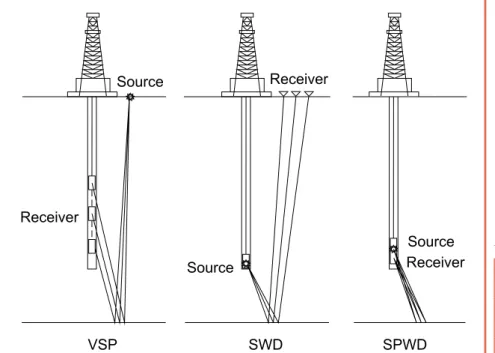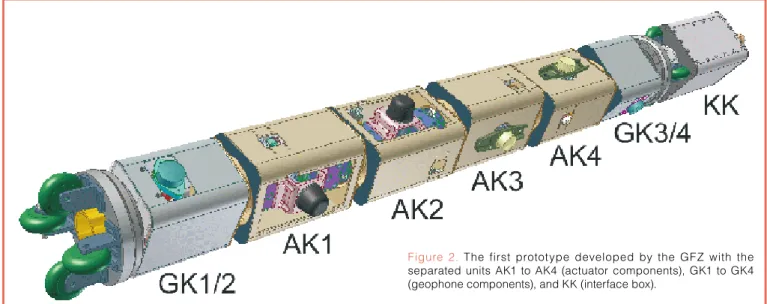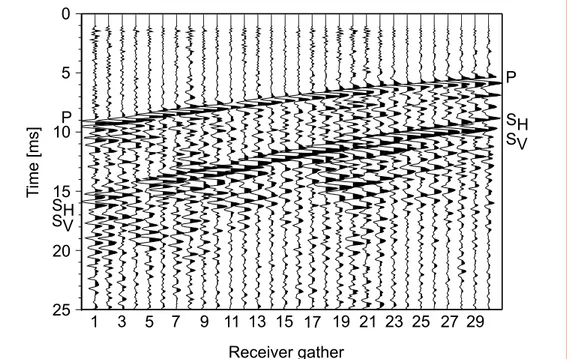Scientific Drilling, No. 9, April 2010
41
Seismic Prediction While Drilling (SPWD): Looking Ahead
of the Drill Bit by Application of Phased Array Technology
by Katrin Jaksch, Rüdiger Giese, Matthias Kopf, Andreas Jurczyk,
Stefan Mikulla, Stefan Weisheit, Marco Groh, and Kay Krüger
doi:
Technical Developments
doi:10.2204/iodp.sd.9.07.2010
Technical Developments
Technical Developments
Introduction
Geophysical exploration is indispensable for planning deep drilling. Usually 2D- or 3D-seismics investigations are applied and, depending on the resulting geologic model for the underground, the drill site and drilling path are deter-mined. In recent years the focus of exploration has shifted towards small-scale geological structures such as local layers and faults. Depending on the source frequencies and the target depth, 2D- or 3D-seismics from surface cannot always resolve such structures in particular at larger depths. In general, signal frequencies of about 30–70 Hz are typical for surface seismic methods. The deeper and smaller the sought-after structures are, the worse will be the resolution. Therefore, borehole seismic measurements like Vertical Seismic Profile (VSP) or Seismic While Drilling (SWD) have been developed (Fig. 1). For the VSP method geophones are normally integrated in the borehole, while the seismic source generates seismic waves at the surface. The SWD method uses the drill bit as the seismic source. Hence, the quality of the seismic signals is highly dependent on the drilled rock and the type of drill bit, but even well-suited rock conditions and adequate drilling may not provide sufficient data quality.
Compared to 2D- and 3D-seismics, the distances between source and receiver to the target are shorter for VSP, and for SWD in particular. Signal frequencies up to about 100 Hz are observed yielding a slightly better resolution compared to surface seismics. However, subtle yet important features (e.g., fault zone) often cannot be identified with certainty. Accordingly, a method or tool that would improve the resolu-tion is of high importance since this would allow adjusting the drilling path to minimize risks and costs of drilling.
A device combining source and receiver immediately behind the drill bit would allow seismic exploration of a range of about 50–100 m ahead of the drill bit with a resolution of one meter. The first prototype of such a Seismic Prediction While Drilling (SPWD) device has been designed and manufactured within this project (Wenke et al., 2010). The tool uses signal frequencies between 500 Hz and 5000 Hz, which are significantly higher than the usual VSP and SWD applications.
A Laboratory Prototype for Seismic
Prediction in Boreholes
A SPWD prototype was designed for laboratory condi-tions without the impact of borehole fluids, high tempera-tures, and pressures and only for tests in horizontal boreholes. It consists of different units for seismic sources, receivers, and data logger. Figure 2 and Table 1 provide details of the instrumentation and dimen-sions. Four standard magnetostrictive actuators (AK1 to AK4; Fig. 2) are aligned along the borehole axis to serve as a cascading source and act as seismic sources. Every single actuator unit can be rotated in steps of 15° around the longi-tudinal axis of the prototype to allow for a variety of source configurations trials.
Technical Developments
Figure 1. Comparison of the different seismic borehole exploration methods VSP, SWD, and SPWD
Source
Receiver
Receiver
Receiver Source
VSP SWD SPWD
Source
Table 1. Parameters of the prototype Length 1.81 m Diameter 20–23.5 cm
Weight ~60 kg
Pressing pneumatic, 6–8 bar
Contact pressure:
actuators ~ 2 kN
42
Scientific Drilling, No. 9, April 2010Technical Developments
Several guide rollers are mounted at the top and the end to move the prototype slightly in the borehole. In order to take measurements, the actuators and geophones must be pressured radially to the borehole wall. The prototype is automatically centered in the borehole. The actuators are decoupled from the prototype body so that all seismic energy is initiated exclusively in the borehole wall.
The actuators are controlled in amplitude and phase. Acceleration sensors are integrated in the front stamps of the actuators to measure the emitted seismic signals. With respect to a specific radiation pattern, the signal for each actuator is calculated based on the local coupling conditions at the borehole wall and then applied.
Test Environment
A test site in the education and research mine “Reiche Zeche” in Freiberg, Germany (Wenke et al., 2010) has been constructed to ensure con-stant environmental condi-tions. Surrounded by three galleries, the site comprises a block of homogeneous high-grade gneisses of almost 50 m x 200 m. Previously used as a test site for seismic sources and receivers of an integrated seismic imaging system (Giese et al., 2006), the site has been expanded. Over thirty 3-component geophone anchors one or two meters long are installed around the area about 4–9 m apart (Fig. 3).
The receivers used are four 3-component geophones integrated in two geophone units (GK1/2 and GK3/4; Fig. 2) with each 3-component geophone mounted in opposite alignment. Again, the geophone units can be rotated in 15° increments perpendicular to the borehole axis. This allows receiving the seismic response from the surrounding rock in defined space directions adjusted to the actuator positions.
The data logger unit (KK; Fig. 2) includes the interface with the external feed cables and the data logger which is used for source activation, triggering, and seismic data acquisition. Additionally, a sensor for inclination, a compass, and an odometer are integrated to determine the position and orientation of the SPWD device in the borehole. An infrared camera at the top monitors the borehole wall.
Figure 2. The first prototype developed by the GFZ with the separated units AK1 to AK4 (actuator components), GK1 to GK4 (geophone components), and KK (interface box).
R1
R15
R30
R24
Source
Richtstrecke
Wilhelm Stehender Süd
Underground Test Site “Reiche Zeche”
30 m
Scientific Drilling, No. 9, April 2010
43
Two horizontal boreholes of 20 m and 30 m length were drilled towards a gallery to test the proto-type. Diamond coring was applied to yield both high-quality cores and true-to-size caliber. The latter was only disrupted at two centimeter-sized frac-ture zones which appear to pass through the whole rock block and which are filled with quartz, feldspar, clay, and fluids. The dike-like fault zones and the galleries act as well-defined reflec-tors for the borehole seismic measurements.
Seismic
Measurements
Several measurements
were implemented during the first year to test the func- tionality of the different units of the prototype (e.g., the pneu-matic contact pressure and the handling of the prototype with rods in the borehole). The performance of the actuators was examined to adapt the parameters of the sweep signals and to maximize the energy of the seismic source in order to reach a sufficient exploration range.
To achieve a directional radiation effect it is essential that all four actuators can be controlled independently of each
other. An increased radiation of seismic wave energy in the direction of the borehole axis allows the view in areas to be drilled. Therefore, every actuator related to amplitude and phase of the source signal must be controlled. The next step for focusing the seismic waves is to use the method of phased array, which has been developed in material sciences and for medical diagnostics by sonography (Hedrick and Hykes, 1996). The signal phases for each actuator can be determined depending on the seismic wave velocities of the surrounding rock, the distance of the actuators to each other, and the frequencies used. Furthermore, the influence of the seismic velocity on the radiation pattern was studied by applying a sonic log with the actuators with a broad frequency band (1–14 kHz).
The influence of different seismic source arrangements was investigated in order to achieve the directional char-acteristics. The main goal of the measurements was to focus the initiated seismic waves in the direction of the borehole axis.
Results
The borehole data overall show a good signal-to-noise ratio. The direct seismic wave field indicates distinct com-pression and shear waves (Fig. 4). As expected, the aniso- tropic gneisses cause shear wave splitting of about ten per-cent. The quality of the seismic data in amplitude and frequency spectra correlates strongly with the fracture den-sity of the rock along the borehole, which was determined with an optical borehole scan and on core. These regions are associated with a lower signal-to-noise ratio. Independent of the local rock conditions, the borehole data show seismic
0 5 10 15 Time (m s )
A1
A2
A3
B2
B3
C1
C2
C3
B1
P
S
-1
Figure 5. Correlated 3 - component recordings of the direct compressional (P) and shear (S) waves at receiver 24 (see R24 in Fig. 3). The source-receiver offset is 17 meters. A – vertical component traces, B – horizontal component traces, C – radial component traces; 1 – sources are in phase, 2 – seismic wave field directed towards Richtstrecke, 3 – seismic wave field directed towards Wilhelm Stehender Süd.
Figure 4. Seismic data of the vertical component at receiver 16 with 30 equidistant shot points in the 30 m borehole. The seismic wave field shows distinct compression (P) and shear (SH, SV) waves and overall a good signal-to-noise ratio.
0
5
10
15
20
25
T
ime [ms]
P
Receiver gather
1
3
5
7
9
11
13
15
17
19
21
23
25
27
29
S
H
S
V
P
S
H
S
44
Scientific Drilling, No. 9, April 2010Technical Developments
reflections from ahead and rearwards. In particular the reflections from the gallery ahead are used for the cali- bration of focusing.
Analysis of several seismic measurements with a focus on the direct seismic waves shows that the phased array tech-nology influences explicitly the directional characteristics of the radiated seismic waves. Their amplitudes can be enhanced three times more in the desired direction and can simultaneously be attenuated in the reverse direction. Figure 4 and 5 present a set of exemplary data recorded at the receiver in geophone anchor R24 (Fig. 3). The source is positioned close to the bottom of the borehole. The frequency content of the source signal is between 500 Hz and 5000 Hz. P-waves arrive at about 3 ms and S-waves at 4.8 ms, corre-sponding to seismic wave velocities of 5700 m s-1 and 3500 m s-1, respectively. The amplitudes of the P-wave are highest on the radial component (C in Figs. 4 and 5) directed to the source. The amplitudes of the S-wave are highest perpendic-ular to the P-wave on the vertical (A) and hori-zontal component (B). If the source wave field is directed towards the gallerie “Wilhelm Stehender Süd” (Fig. 3), the amplitude of the S-wave is clearly amplified (B3 and C3) in comparison to source signals without manipulation of wave field direction (B1 and C1). A slight increase of P-wave ampli-tudes can also be observed in the radial component in C3 compared to C1. If the wave field is directed towards the gallery “Richtstrecke” (Fig. 3), the amplitude decreases slightly on the radial component C2 compared to original source wave field in C1, whereas no significant reduction of amplitudes is observed on the vertical (A2) and horizontal (B2) components.
Conclusions
The application of the phased array technology for the directional investigation of borehole surroundings is very promising. However, focusing of the seismic waves has to be improved to maximize the energy in the desired direction. For that purpose several measurements and modeling of different source and receiver configurations must be done to calibrate the initiated seismic signals of the sources. The application of a phased array source system influences the processing and imaging of the data. Methods developed for surface seismic and VSP measurements have to be adapted to take advantage of the improved data quality and known directional information of the recorded wave field.
The next step will be the development of a wireline SPWD prototype for vertical boreholes with depths to 2000 m. Modifications in the arrangement of the different units will be necessary, as well as an adaptation to fluid-fill under the conditions in deep boreholes with respect to pressure and temperature. If the wireline prototype tests successfully, we plan to implement the tool into the downhole assembly of a drill string as a Logging-While-Drilling tool. This would allow a seismic prediction of structures or faults while
drilling and will help to reduce risks encountered while drilling.
Acknowledgements
We are grateful for support from the technical team of the “Reiche Zeche” for the preparation of the test site and from our partners in the SPWD project, the TU Bergakademie Freiberg, GeoThermal Engineering GmbH, and Herrenknecht Vertical GmbH. The project (S)PWD ((Seismic) Prediction While Drilling) is funded by the German Federal Environment Ministry, BMU.
References
Giese, R., Dickmann, Th., Eppler, Th., and Lüth, S., 2006. Seismic tomography to investigate the tunnel surroundings of the
Side Gallery West of the multifunctional station Faido. In
Löw, S. (Ed.), Geologie und Geotechnik der Basistunnels am
Gotthard und am Lötschberg, Tagungsband zum Symposium Geologie Alptransit, Zürich (vdf Hochschulverlag an der ETH), 145–154.
Hedrick, W.R., and Hykes, D.L., 1996. Beam steering and focusing
with linear phased arrays. J. Diagn. Med. Sonogr.,
12:211–215.
Wenke, A., Giese, R., Jaksch, K., Kopf, M., Kreuter, H., Reich, M., Reinhardt, J., and Sohmer, M., 2010. (S)PWD – (Seismic) Prediction While Drilling: Development of a new high-reso-lution Seismic While Drilling (SWD) concept for
geother-mal drilling. Proceedings World Geothermal Congress,
Indonesia, 25–29 April 2010.
Authors
Katrin Jaksch, Helmholtz Centre Potsdam - GFZ German
Research Centre for Geosciences, Scientific Drilling, Telegrafenberg, F 358, D-14473, Potsdam, Germany, e-mail: kawi@gfz-potsdam.de.
Rüdiger Giese, Matthias Kopf, Andreas Jurczyk, Stefan
Mikulla, Stefan Weisheit, Marco Groh, Kay Krüger


